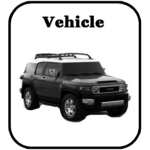Best Vehicle For The Snow
 A cowboy seeking adventure needs his trusty steed. A cowboy cannot chase the bad guy, save the lady or gallop triumphantly into the sunset with a lame horse. Roy Rogers had Trigger, and John Wayne, Old Dollor.
A cowboy seeking adventure needs his trusty steed. A cowboy cannot chase the bad guy, save the lady or gallop triumphantly into the sunset with a lame horse. Roy Rogers had Trigger, and John Wayne, Old Dollor.
Likewise, a skier or boarder with a lame vehicle can’t get from one resort to another. In short, there is no GNASA without a reliable vehicle. Car problems of any kind can stop you in your tracks. The costs can be very high; especially, if you’ve spent thousands of dollars on lift tickets and accommodations, taken off work and canceled other plans. All of these are common requirements of a GNASA.
Note: There some occasions when a GNASA may involve a bus tour or other third party transportation options. In these cases, the third-party takes responsibility for getting you to your resorts. We like control over our mode of transportation. One could make an argument that if your not an experiences snow and ice driver and don’t want to spend the money to ensure you have the right vehicle (owned or rented) you’re better off letting someone else do the driving.
We’re going to cover the most important components of a vehicle that best support snow and ice driving. To ensure that you understand these components were also going to cover some car basics, physics, and mechanical issues.
All of this is to help understand the two key areas necessary to pick (or rent) a great snow car. These are (1) how the wheels get power; and (2) how the car stops and slows. Finally, we talk about tires. One and two work better in ice and snow with the right tires.
Here are the essential components of a car that tie directly to a reliable snow vehicle:
- Drivetrain
- Four Wheel Drive Vehicles Verus Alternatives
- Anti-locking Braking Systems (ABS)
- Tires
See the navigation menu on the right to reach a detailed explanation in these areas.
If you’re not into learning about the gory details, we offer a few quick tips below.
We’re not talking brands, at the moment. We’re talking key snow and ice performance features. I want a drivetrain that can manage all wheels. Both 4WD and AWD will allow do this. AWD and 4WD are your only legitimate choices for a GNASA vehicle. Managing four wheels on roads with poor traction is needed to stay on the road and lower your chances of sliding. I also want ABS that manages all four wheels.
Quick Tip – 4WD / Four-channel, four-sensor ABS
If your an off roader or have experience with part-time four-wheel drive (4WD) and know how these cars handle, 4WD may be your best choice. 4WD have low gears that off-roaders use to climb rocks, and hills. If you have specialty needs like climbing iced and snowy hills, the low gear can literally be a lifesaver. However, I’d make sure the anti-locking braking system (ABS) manages each wheel individually. 4WD usually lock hubs when the 4WD is engaged, and that’s to allow for lateral wheel slippage. I like ABS control at the wheel level so when I’m ascending or descending snowy or icy roads and need to apply some break, I’m getting some wheel level monitoring of left and right wheels. Without ABS wheel control on a 4WD, I find that both my torque, and brakes are similarly applied creating the potential to slide on turns in certain conditions.
If you go off-roading and need the dedicated low gear built into 4WD systems, 4WD is probably your top choice.
AWD / Four-channel, four-sensor ABS
If you really want the vehicle to work for you, across all conditions, AWD systems designed for snow and ice are simply unbeatable. AWD is always on so you don’t have to think about it. As the road changes, so will your traction. Newer cars have all sorts of advanced electronics that can apply torque independently to each wheel optimizing traction across wintry conditions. It’ always on so you don’t have to think about it. As the road changes, so will your traction.